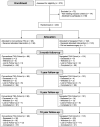No advantage with navigated versus conventional mechanically aligned total knee arthroplasty-10 year results of a randomised controlled trial
- PMID: 36166095
- PMCID: PMC9957903
- DOI: 10.1007/s00167-022-07158-1
No advantage with navigated versus conventional mechanically aligned total knee arthroplasty-10 year results of a randomised controlled trial
Abstract
Purpose: Computer-assisted surgery (CAS) total knee arthroplasty (TKA) remains a controversial area of surgical practice. The aim of this study is to report the ten-year revision rates and patient-reported outcome measures (PROMS) of a single-blinded, prospective, randomised controlled trial comparing electromagnetically (EM) navigated and conventional TKA.
Methods: 199 patients were randomised to receive either EM navigated or conventional TKA where the aim of implantation was neutral mechanical alignment in all cases. Ten-year revision rates were collated and compared between the two intervention groups. Longitudinal PROMS data was collected prospectively at various time points up to 10 years post-operatively.
Results: Over the ten-year period, there were 23 deaths (22.8%) in the EM navigation cohort and 30 deaths (30.6%) in the conventional cohort. At 10 years post-operatively, there was no statistically significant difference in all cause revision between the EM navigation and conventional cohort (4.0 vs 6.1%, p = 0.429). When analysing causes of revision that might be influenced by utilising EM navigation, there was no statistically significant difference in revisions (3.0% EM navigated vs 4.1% conventional group, p = 0.591). Patients that received navigated TKAs had improved Oxford Knee Society, American Knee Society Score and range of motion at 3 months following surgery compared to conventional TKA (p = 0.002, p = 0.032, and p = 0.05, respectively). However, from 1 to 10 years post-operatively, both interventions had equivalent outcomes.
Conclusion: There is no difference in revision rates or clinical outcomes comparing EM navigated versus conventional TKA at ten-year follow-up. The expected mortality rate makes it unlikely that a difference in revision rates will reach statistical significance in the future. In the setting of an experienced knee arthroplasty surgeon, it is difficult to justify the additional costs of CAS in TKA surgery.
Level of evidence: I.
Keywords: Computer Assisted Surgery; EM Navigation; Knee arthroplasty; Randomised controlled trial.
© 2022. The Author(s).
Conflict of interest statement
The authors declare no competing interests.
Figures




Similar articles
-
2017 Chitranjan S. Ranawat Award: Does Computer Navigation in Knee Arthroplasty Improve Functional Outcomes in Young Patients? A Randomized Study.Clin Orthop Relat Res. 2018 Jan;476(1):6-15. doi: 10.1007/s11999.0000000000000000. Clin Orthop Relat Res. 2018. PMID: 29389753 Free PMC article. Clinical Trial.
-
Population-based Survivorship of Computer-navigated Versus Conventional Total Knee Arthroplasty.J Am Acad Orthop Surg. 2020 Oct 15;28(20):857-864. doi: 10.5435/JAAOS-D-19-00548. J Am Acad Orthop Surg. 2020. PMID: 31934926
-
Conventional versus computer-navigated TKA: a prospective randomized study.Knee Surg Sports Traumatol Arthrosc. 2017 Jun;25(6):1778-1783. doi: 10.1007/s00167-016-4196-9. Epub 2016 Jun 15. Knee Surg Sports Traumatol Arthrosc. 2017. PMID: 27306985 Clinical Trial.
-
No differences in mid- to long-term outcomes of computer-assisted navigation versus conventional total knee arthroplasty.Knee Surg Sports Traumatol Arthrosc. 2020 Oct;28(10):3183-3192. doi: 10.1007/s00167-019-05808-5. Epub 2019 Nov 29. Knee Surg Sports Traumatol Arthrosc. 2020. PMID: 31784782 Review.
-
Navigated and Robot-Assisted Technology in Total Knee Arthroplasty: Do Outcome Differences Achieve Minimal Clinically Important Difference?J Arthroplasty. 2022 Aug;37(8):1562-1569. doi: 10.1016/j.arth.2022.03.075. Epub 2022 Mar 30. J Arthroplasty. 2022. PMID: 35367335
Cited by
-
Correlation of revision rate of unicompartmental knee arthroplasty with total knee arthroplasty: a meta-analysis of clinical studies and worldwide arthroplasty registers.Arch Orthop Trauma Surg. 2024 Nov;144(11):4873-4886. doi: 10.1007/s00402-024-05574-1. Epub 2024 Oct 15. Arch Orthop Trauma Surg. 2024. PMID: 39404769 Free PMC article.
-
Comparison of the accuracy and efficacy of different assistive techniques in primary total knee arthroplasty: A network meta-analysis.J Exp Orthop. 2024 Nov 28;11(4):e70098. doi: 10.1002/jeo2.70098. eCollection 2024 Oct. J Exp Orthop. 2024. PMID: 39619732 Free PMC article.
-
Clinical and Radiological Outcomes of Computer-Assisted versus Conventional Total Knee Arthroplasty at 5-Year Follow-Up: Is There Any Benefit?J Pers Med. 2023 Sep 8;13(9):1365. doi: 10.3390/jpm13091365. J Pers Med. 2023. PMID: 37763133 Free PMC article.
-
Impact of navigation on functional and radiological outcomes after total knee arthroplasty: a retrospective analysis of one hundred and ninety cases.Int Orthop. 2025 Aug 18. doi: 10.1007/s00264-025-06638-6. Online ahead of print. Int Orthop. 2025. PMID: 40820163
-
Mapping the reporting practices in recent randomised controlled trials published in Knee Surgery, Sports Traumatology, Arthroscopy: A scoping review of methodological quality.J Exp Orthop. 2025 Jan 7;12(1):e70117. doi: 10.1002/jeo2.70117. eCollection 2025 Jan. J Exp Orthop. 2025. PMID: 39776837 Free PMC article.
References
-
- AOANJRR (2019) Hip, Knee & Shoulder Arthroplasty: 2019 Annual Report. Adelaide: AOA
-
- Clark AN, Hounat A, O'Donnell S, May P, Doonan J, Rowe P, Jones BG, Blyth MJG. Electromagnetic navigated versus conventional total knee arthroplasty-a five-year follow-up of a single-blind randomized control trial. J Arthroplasty. 2021;36(10):3451–3455. doi: 10.1016/j.arth.2021.06.007. - DOI - PubMed
Publication types
MeSH terms
LinkOut - more resources
Full Text Sources
Medical
Research Materials

